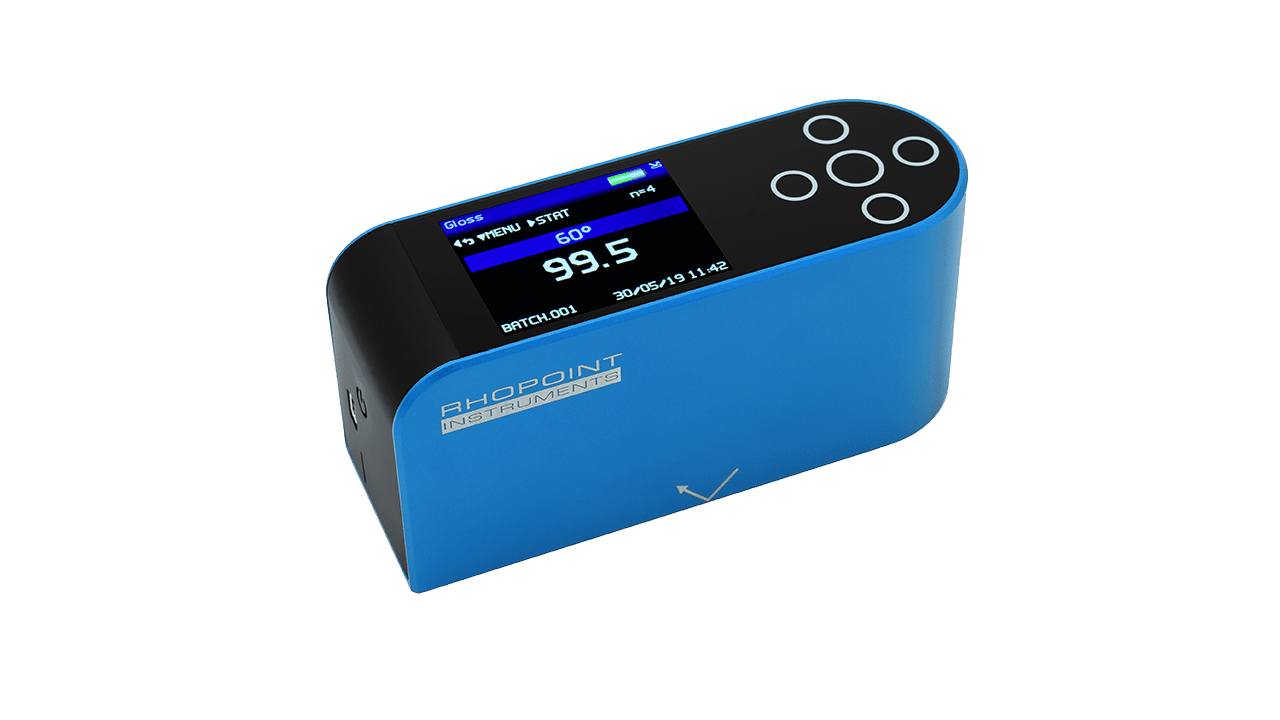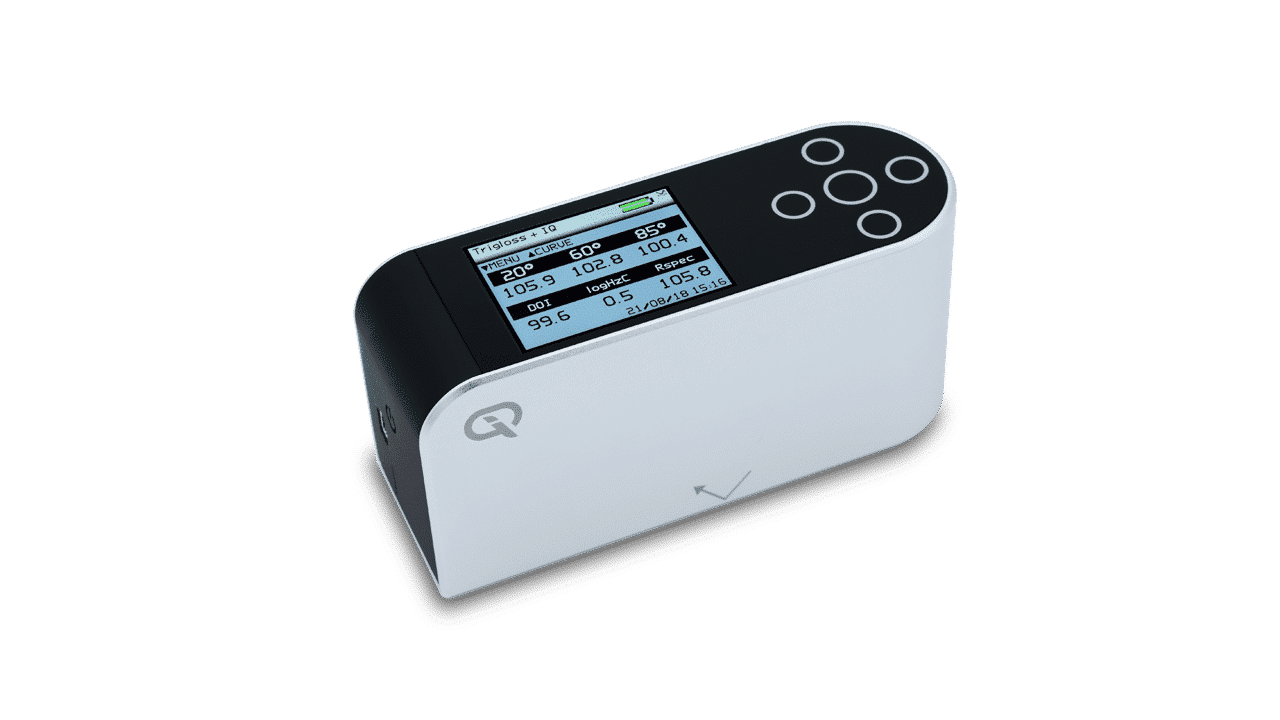A gloss meter is an instrument designed to measure the specular reflection gloss of a surface. Gloss is determined by projecting a light at a fixed intensity and angle onto a surface and measuring the amount of reflected light at an equal but opposite angle. This article explores the specific characteristics, applications, and limitations of a 60-degree gloss meter, as well as the advantages of more advanced instruments such as the Rhopoint IQ, which measures additional surface attributes.

Understanding the 60 degree gloss meter
The 60 degree gloss meter is the most widely used type in the gloss measurement spectrum. This instrument is so named because it measures gloss at a 60-degree angle, which is considered the universal measurement angle. This angle is used for most applications, from low to high gloss surfaces, making it a versatile tool in various industries.
When light is directed at a surface at a 60 degree angle, the gloss meter sensor is positioned to capture and measure the light that is reflected at an equal but opposite angle. The intensity of this reflected light is measured and quantified in gloss units (GU). A highly reflective, mirror-like surface would have a higher GU, while a dull or matte surface would score lower. The main international standard for measuring gloss at 60 degrees are BS EN ISO 2813 and ASTM D523.
Applications and Industries Using 60 degree gloss meters
Automotive Industry
In the automotive sector, gloss meters are essential for ensuring the quality and consistency of paint finishes on vehicles. A uniform gloss level is crucial for aesthetic appeal and brand consistency.
Furniture and Woodworking
In furniture and woodworking, gloss meters help in achieving the desired finish on products, whether it’s a high gloss for modern furniture or a subdued matte finish for traditional pieces.
Paints and Coatings
Manufacturers of paints and coatings rely heavily on gloss meters to test their products, ensuring that they meet the desired specifications for reflectivity and consistency.
Printing
The printing industry sector measures gloss to ensure that printed materials have maximum appeal for the consumer. Controlling the gloss helps brand to differentiate and create the perception of premium quality.
Quality Control in Manufacturing
Many manufacturing industries utilise gloss meters as part of their quality control processes to ensure product consistency and meet industry standards.
Limitations of Solely Using a 60 degree gloss meter
While the 60 degree gloss meter is versatile, it has limitations, especially when dealing with high gloss or specialised finishes.
Inadequate for High or Low Gloss Surfaces
For extremely high gloss surfaces, a 60 degree gloss meter might not provide the most accurate measurements. In such cases, a 20 degree gloss meter, which is more sensitive to higher gloss levels, is often more suitable.
Likewise, small changes in a very matt surface may not be detected by a 60 degree gloss meter and may require the more specialised 85 degree angle which detects these changes with greater sensitivity.
Lacks Surface Detail Analysis
A standard gloss meter does not measure surface imperfections like haze or orange peel, which are crucial in some industries. Haze, for instance, can affect the clarity and appearance of a surface, while orange peel refers to the texture of a surface that resembles the skin of an orange, often undesirable in high-quality finishes.
The Rhopoint IQ: A Comprehensive Solution
The Rhopoint IQ addresses these limitations by offering a more comprehensive analysis of surface finish. It not only measures gloss but also quantifies haze and orange peel. This provides a more complete understanding of the surface quality, which is essential in industries where these attributes are critical.

Measuring Haze and Orange Peel
Haze can be a significant issue in high gloss finishes as it affects the sharpness of an image reflected by a surface. The Rhopoint IQ’s ability to measure haze helps in identifying this issue, which might not be detected by a standard gloss meter. Similarly, measuring orange peel is vital in industries like automotive manufacturing, where surface texture is as important as gloss level.
Benefit for High Gloss Finishes
For industries dealing with high gloss finishes, the Rhopoint IQ offers a distinct advantage. It provides a more nuanced and detailed analysis of the surface, ensuring that both the gloss level and the quality of the finish meet the highest standards.
In Summary,
The 60 degree gloss meter remains a staple in many industries for its versatility and reliability in measuring medium to high gloss levels. However, its limitations become apparent when dealing with high gloss finishes or when a more detailed analysis of surface imperfections is required. In such scenarios, advanced instruments like the Rhopoint IQ, which measure additional surface characteristics like haze and orange peel, offer a more comprehensive solution, ensuring that the quality and aesthetics of the finish meet the highest standards. Therefore, while the 60 degree gloss meter is an invaluable tool in many applications, the Rhopoint IQ represents a significant advancement in the field of gloss measurement, catering to the evolving needs of industries prioritizing surface perfection.
